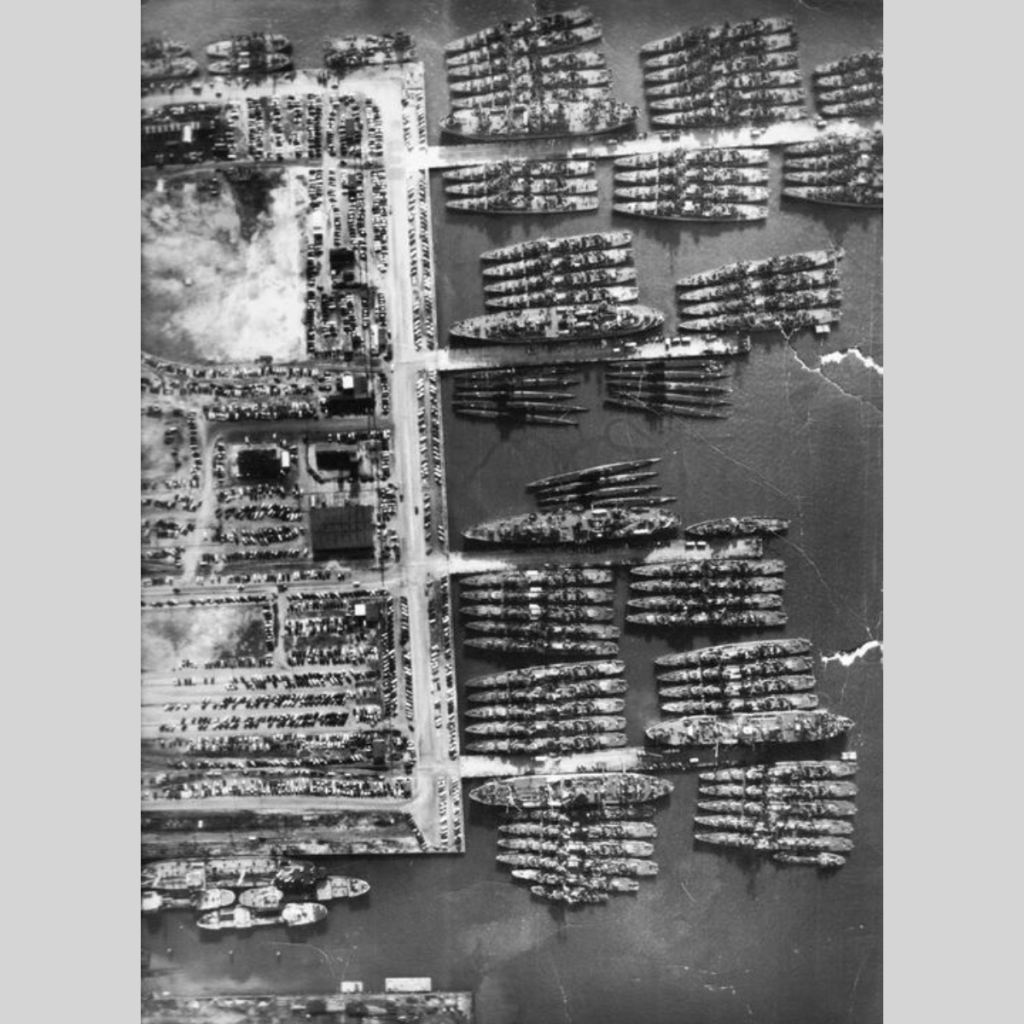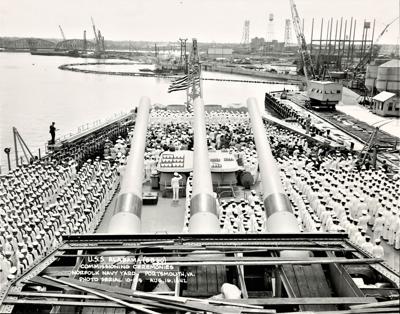
NORFOLK
Its biggest World War II ship was named after a joke the president made. It repaired an ally’s aircraft carrier in secret, while the enemy publically claimed it sunk. It transformed a sabotaged enemy cargo liner into a transport ship carrying thousands of American troops across the Atlantic.
These are just some of the more surprising stories of Norfolk Naval Shipyard’s (NNSY) service as one of the United States Navy’s most vital shipbuilding and repair facilities during World War II. From January 1, 1940, shortly after war erupted in Europe, to its end with Japan on V-J Day August 14, 1945, the shipyard repaired, altered, converted, and worked on approximately 6,850 naval vessels, recorded as more than 27 million tons of naval might. In the midst of urgent repairs and conversions, more than 100 new ships and landing craft were built, and millions of dollars in manufactured products were churned out for the Navy.
To perform its unprecedented amount of work, the shipyard—then known as Norfolk Navy Yard—more than doubled its physical size, turbocharged its productive capacity, and bolstered the workforce from 7,625 at war’s inception to a peak of 42,893 in 1943. In all, this bigger, bloodier sequel to the Great War would have lasting impact at NNSY that still reverberates today.

Fixing to Fight
As its highest priority given the urgency to send ships back out to to rejoin the fight, NNSY devoted more than half its World War II work to repairs. More than 800 ships docked for repair in 1944 alone—an average of more than two per day. To facilitate such a volume of work, skills as shipyard artisans and urgency as patriotic Americans worked in tandem for the thousands of NNSY employees laboring around the clock and across the calendar. Borrowing parts between ships, tapping into the shipyard foundry to make components, developing an extensive salvage system and using quick-drying paints helped speed repairs. In one instance, even the Greyhound Bus Company was called to assist in supplying a diesel engine.
NNSY’s first casualty of World War II arrived May 12, 1941, somehow as quietly as it was sizable. After German dive bombers hammered the British aircraft carrier HMS Illustrious during a seven-hour attack off Malta, it arrived at the Navy yard under its own power to undergo repairs to its flight deck, most of its electrical system, and extensive equipment. Local news media helped keep the carrier’s fate a secret, thanks in part to Secretary of the Navy Frank Knox asking people to keep mum on the matter. The widespread vow of silence proved effective, as during its six months in the yard, German broadcasts claimed on multiple occasions Illustrious had been sunk. In addition to British vessels, French, Canadian, Dutch, Russian, and Australian ships were among the 216 foreign warships repaired or overhauled at NNSY during the war, beneficiaries of the Lend-Lease Bill sharing resources between Allied nations. During several of these repair jobs, shipyarders had to contend with unfamiliar systems on foreign ships.
In the midst of that workload, NNSY repaired the U.S. Navy’s own warships, damaged from bombs, torpedoes and kamikaze attacks alike. These included the heavy cruiser USS Chester (CA-27), damaged near Guadalcanal in October 1942 when a Japanese torpedo hit midship on the portside and smashed the forward engine rooms, killing 11 and wounding 12 more. When the destroyer USS Kendrick (DD-612) had its stern heavily damaged by a German dive bomber in September 1943, the shipyard built a new one. After the light cruiser USS Honolulu (CL-48) suffered a portside torpedo attack prior to the Battle of Leyte Gulf in October 1944, NNSY restored it to become a training ship. The Navy yard made a new bow for USS Lindsey (DM-32) after a dramatic and deadly Pacific battle in April 1945 with two kamikaze planes striking the vessel, killing 57 and wounding 57 others. Sometimes multiple repair jobs arrived on the same day, as in the case of USS Hobson (DD-464) and USS Sangamon (CVE-26) in June 1945, both victims of kamikaze attacks. Whether it be smashed hulls, crippled machinery, or critical electrical equipment to repair, Norfolk Naval Shipyarders married ingenuity and efficiency to quickly fix vessels and return them to sea.
An excess of ships crowds the piers of Norfolk Naval Station at the end of WW2
It’s a Sabotage!
Beyond battle repairs, ship conversions and alterations at NNSY may have proved equally significant in helping secure victory. Continually shifting priorities based on naval needs—one week might have been landing craft and cargo ships, while the next was attack transports and command ships—NNSY performed a number of remarkable conversion jobs. Not just limited to changing the type of vessel, but even the country it served, NNSY transformed the 20,000-ton German cargo liner TS Windhuk into the U.S. Navy transport USS Lejeune (AP-74) beginning in spring 1943. The vessel was captured in South American waters after its crew sabotaged it by melting its boiler tubes, pouring concrete into the main propulsion machinery, and using torches to ruin main shaft roller bearings. Over a period of eight months, NNSY workers installed new turbines and boilers, repaired the main shafts, added armament, and repurposed the ship to transport troops. Lejeune subsequently made ten round trips across the Atlantic, able to carry up to 4,650 servicemembers at a pop.
Building for Victory
Given their value in the Pacific during World War II, the shipyard devoted great attention and effort in constructing its three Essex-class aircraft carriers. While many U.S. carriers of the era were named after pivotal battles in national history, NNSY’s first, USS Shangri-La (CV-38), immediately distinguished itself by being named after a joke. When reporters questioned President Franklin D. Roosevelt about the launch site of the American B-25s making the first bombing raid on Japan in April 1942, he quipped that they came from “Shangri-La,” the mythical land in James Hilton’s novel Lost Horizon. In protecting the carrier USS Hornet (CV-8) from enemy retaliation, Roosevelt also inspired the name of a carrier that helped end the war. Reporting to the Fast Carrier Task Force in April 1945, Shangri-La launched air strikes on targets in Tokyo, provided close air support over Okinawa, airdropped supplies to Allied prisoners in Japan and later assumed occupation duties. While NNSY’s other two carriers—USS Lake Champlain (CV-39) and USS Tarawa (CV-40)—were commissioned too late in 1945 to participate in battle, Lake Champlain set speed records transporting more than 5,000 Americans home from Europe as part of Operation Magic Carpet.
The shipyard showcased great versatility in constructing a variety of ships during this period, including the battleship USS Alabama (BB-60), which still exists as a museum ship in its namesake state. Alabama earned nine battle stars providing fire support and anti-aircraft screening in the invasions of Saipan, Guam, and Okinawa, blasting Japanese factories and defenses to the end of the war. NNSY’s destroyers USS Herndon (DD-638) and USS Shubrick (DD-639) performed antisubmarine patrol duty and fire support, including on D-Day, as well as escorted troopships across the Atlantic. At war’s end, Herndonsailed to China where a Japanese surrender ceremony took place aboard. In a testament to the Navy yard’s craftsmanship, the unsinkable Shubrick survived multiple deadly attacks, returning to the U.S. on one screw after being struck by a 500-pound bomb at Palermo, and another return trip on one engine after a kamikaze attack in the Pacific. NNSY also constructed ten destroyer escorts, as well as the minesweepers USS Raven (AM-55), USS Osprey (AM-56) and USS Auk (AM-57), with Raven and Osprey participating in minesweeping in advance of D-Day. NNSY built 50 50-foot landing craft, mechanized (LCM) in summer 1942, able to transport 30 tons of cargo ashore for invasions at Normandy, North Africa, France, Italy and the Pacific islands. The shipyard also built 20 tank landing ships to support a multitude of amphibious assaults in Europe and the Pacific.
Mettle in Manufacturing
Though less dazzling than repairing a crippled aircraft carrier or constructing a 34,800-ton one from scratch, it takes many products and parts to win a war, and NNSY manufactured
$200 million worth of goods from 1939 through 1945. Boats of all types, from whale boats to admirals’ barges, were built. More than 5,000 diesel engines of three types–25, 65 and 105 horsepower–were built for small boats. Motor blocks and other major parts were cast in NNSY’s foundry, with engines assembled in the yard’s Inside Machine Shop. Many went directly into the small boats being built in the yard, while hundreds of others were shipped out to naval bases. Other manufactured products included metal furniture, anchors, chains and turret castings. Turbine blades, destroyer propellers, bomb casings, bomb racks, other ordnance items, and various machinery parts came from NNSY’s shops.
“World War II left a lasting impact in America’s Shipyard that’s felt even 75 years later, as NNSY doubled in physical size, vastly increased its productive capacity, and proved the possibilities of what can be accomplished when the workforce rallies around a common, vital goal,” said Shipyard Commander Captain Kai Torkelson. “And just as our predecessors did 75 years ago, it’s on the shoulders of every one of us at this great shipyard to maintain our nation’s ships, and deliver unmatched warfighting capability to our nation’s fleet.”
